A vibrant voice chronicles the renaissance of downtown L.A.
Catching up with Ed Fuentes isn’t easy. A running start helps. The 52-year-old Fuentes — I call him the human cyclone — moves so fast on so many fronts in any given day that whiplash is possible: photographer, muralist, blogger, modern-day historian, humorist.
He briefly touched down in the Arts District last week. But it wasn’t that simple, of course.
Like one of the Weather Channel’s “storm chasers,” I tracked him from where he was interviewing a muralist in East Los Angeles to a site just off Alameda Street in downtown L.A., where he had been hired to shoot publicity stills for a local theater company. With luck, I would have a few minutes in the eye of this creative tornado.
In every sense, Fuentes is larger than life. He’s not exactly tall and not exactly slender, often a bit rumpled, with a few days of stubble and a full head of hair like coarse steel wool. He’s always equipped with at least one camera and a broad sense of humor. In fact, when he said we could meet at the Pie Hole, a restaurant on Traction Avenue, I thought he was joking.
It is his passion for downtown L.A. that has set him apart, chronicling its renaissance and emerging arts community over the last half a dozen years in a series of blogs that give a sense of the area’s history as much as its beauty, including his own View From a Loft and, most recently, Departures for KCET.
He may be little-known to large segments of the city he loves, but in downtown, his voice has endured.
“I decided to become a writer because I like to challenge myself, and it’s the hardest thing I could think of to do,” he said. “I may spend hours on a sentence or a paragraph.”
The Riverside native infuses everything with a sense of the theatrical, rooted in his earliest experiences in drama and set design, which grew to include graphic arts, photography and murals. But in his early days, there was no ethnic connection to murals, he said, just a question of design and the impact of working on a large scale outdoors.
“I started experimenting with my own form of digital murals, using my photography to ward off copyright issues and advance the idea of creating content beyond painting,” he said, “maybe updating murals for the next century.”
Fuentes’ resume slips out in bits and pieces, such as how taking a few classes with the Royal Shakespeare Company taught him to project his voice so that when he was photographing the unveiling of the downtown Clifton’s Cafeteria facade, he could yell from across the street at the men pulling the tarp and get them to pose for a shot.
Although he’s captured many portraits of downtown, my favorite is a photograph that is the perfect rebuttal to the notion that Los Angeles is a city without history: It shows a parking lot on Main Street where asphalt obscures much of the mosaic tile floor of an old business.
“It’s all beneath the pavement,” Fuentes said. “Not even history because the history is lost. There’s just rumors.”
History was one reason Fuentes began View From a Loft in 2006.
“This is why I take photos of downtown public art and buildings. You never know what’s going to be gone next,” he said.
“Murals were designed to be art for the masses, and in the case of ethnic-based murals, spoke for those underrepresented. In Los Angeles, its own identity is lost because it’s a region people come to reinvent the city, and/or reinvent themselves. This current legacy of remaining murals, plus the manifesto of current artists, may not realize their work represents another undervalued voice: The city’s own history.
“When I was looking to create my own form of narrative, I sensed the traditional L.A. mural, in its best form, is a novel.... I thought to myself, what is a modern way of storytelling, and used a newspaper column as a tone … ended up writing more to get a higher level of storytelling.”
But going from painting murals to working with words wasn’t easy at first. Then he realized that he was thinking in Spanish and writing in English.
“I said, ‘I must get into a character, like I was in theater, and write like a white guy … or an angry Latino muralist … or because I like to challenge myself, a lesbian feminist.”
Fuentes excused himself to begin setting up his cameras — he had roped off a couple of parking spaces outside the Cornerstone Theater Co. for the photo shoot.
He returned with the news that Andrea Alonso, a student at USC’s Annenberg School for Communication and Journalism, had arrived to conduct a video interview about Los Angeles murals, and we broke off our conversation.
Outside, in the middle of Traction Avenue, Fuentes stood in front of a video camera and clipped on a microphone while the theater company members began gathering on the sidewalk to be posed for their photos. Up the street, a semi was creeping around the corner, so Fuentes turned around to direct the driver. The human cyclone was on the move again.
More to Read
Sign up for Essential California
The most important California stories and recommendations in your inbox every morning.
You may occasionally receive promotional content from the Los Angeles Times.










